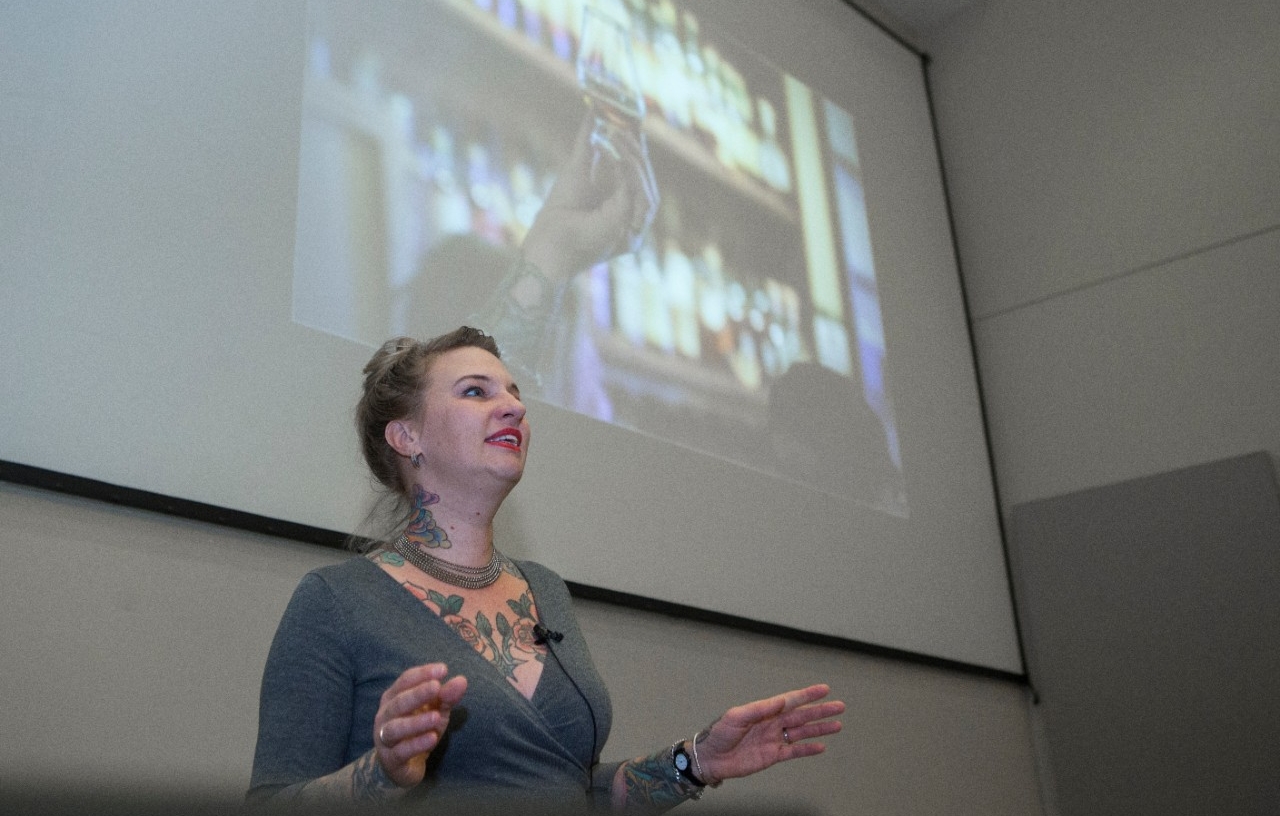Cincinnati businesswoman Molly Wellmann gives a lecture on the origins and medical uses of alcohol to a class of UC medical botany students.
Serving up cocktails and history
Cincinnati entrepreneur and mixologist Molly Wellmann gives UC botany students a lesson in the origins and medical uses of alcohol.
By Michael Miller
513-556-6757
Photos by Joseph Fuqua II/UC Creative Services
Feb. 28, 2018
Molly Wellmann apologized good naturedly Wednesday for not being a morning person as University of Cincinnati pre-med and biology students took their seats in a lecture hall.
Wellmann, owner of several Tristate bars, a cafe and a catering business, hosted one of her weekly bourbon tastings the previous night. UC biology professors Theresa Culley and Eric Tepe invited Wellmann to discuss the origins and medicinal uses of alcohol for students in their medical botany class in the McMicken College of Arts and Sciences.
Wellmann is an expert on the topic. She is a five-time winner of CityBeat’s Best Mixologist/Bartender in Cincinnati. She wrote the 2013 book “Handcrafted Cocktails: The Mixologist’s Guide to Classic Drinks for Morning, Noon & Night.” And she has cultivated a lifelong interest in the colorful history and social customs of the drinks that shape her businesses.
“When you come into one of my bars or even if it’s at an event, I’ll tell you a tidbit of the history of what you’re drinking,” she said. “When you have a story to go with it, it turns into an experience. I think that’s really important.”
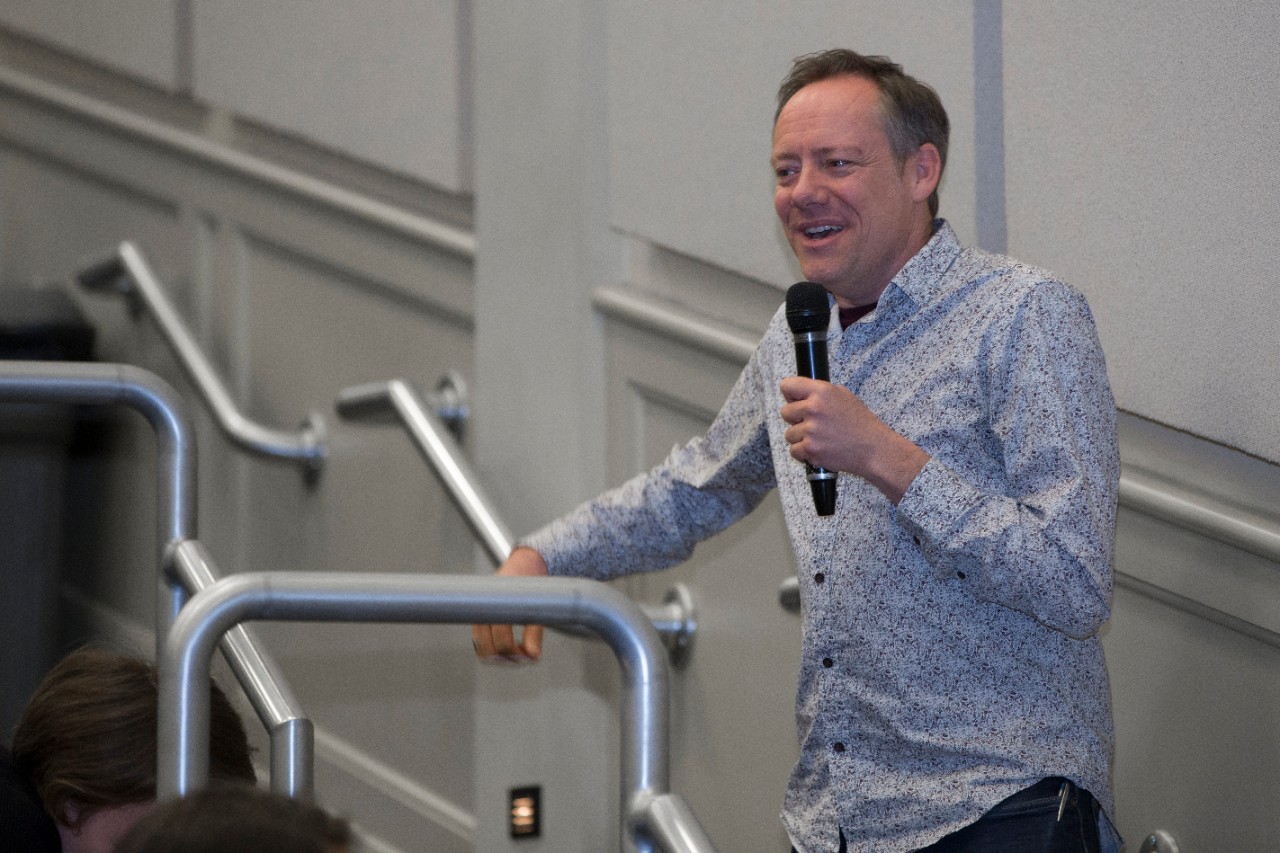
UC biology professor Eric Tepe introduces guest speaker Molly Wellmann during the medical botany class he co-teaches with UC biology professor Theresa Culley.
UC’s medical botany class examines how plants produce chemicals that are medically beneficial. Culley, an expert in invasive species and editor of the journal Applications in Plant Sciences, teaches the class with Tepe, director of UC’s Herbarium.
“People may think of herbal medicine when you say ‘medical botany.’ But in class we’re focusing on the medicines we use every day, many of which are derived from plants. Aspirin is a classic example,” Culley said.
Often, labs can manufacture plant-derived compounds, but plants remain an important source of new drugs, she said. The U.S. Food and Drug Administration approves new plant-based drugs every year to treat pain or disease.
“With increasing antibiotic and malarial resistance, we’re going back to the plants for more effective treatments,” she said.
Culley said Wellmann’s lecture touched on some topics covered in her class such as the origins of quinine and other malarial treatments.
“She understands the history of different plant species and how they’re important in her livelihood,” she said.
“People may think of herbal medicine when you say ‘medical botany.’ But in class we’re focusing on the medicines we use every day, many of which are derived from plants. Aspirin is a classic example.”
‒ Theresa Culley, UC biology professor
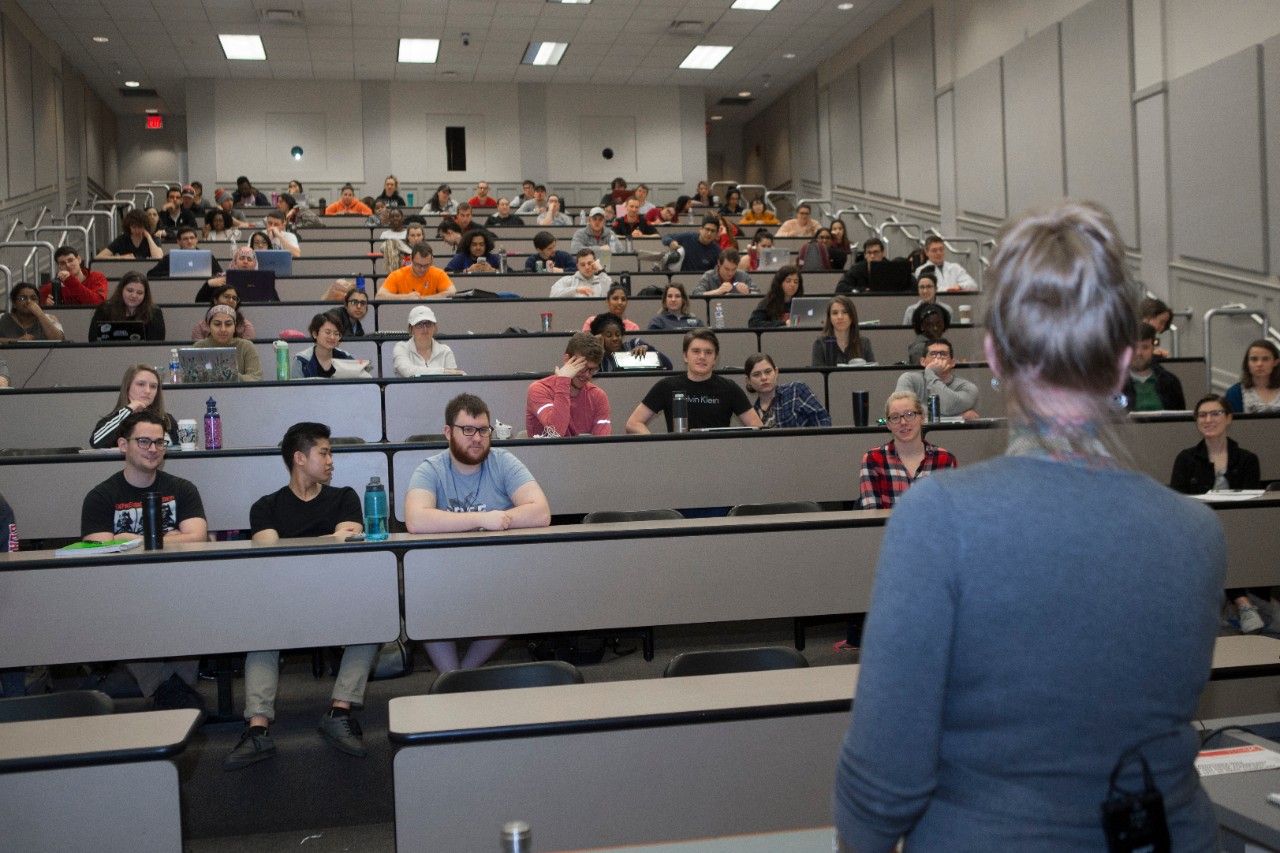
UC students in the medical botany class listen to Molly Wellmann's presentation.
Wellmann belongs to the Mercantile Library of Cincinnati, where she conducts much of her local historical research. The Cincinnati native is a regular lecturer for UC’s Communiversity.
“When I’m not running my bars or teaching classes, I usually have my nose in a book,” she said.
On Wednesday, she discussed how alcohol in its many forms evolved from necessity and by opportunity.
Before the advent of modern sanitation and sewage treatment, drinking water in U.S. cities could kill you. Instead, people often turned to beer, wine and spirits, she said.
Bitters have a long association with improving digestion, she said. Sailors added bitters to their rum to help with seasickness. Bartenders adopted this practice for popular before-dinner aperitifs and after-dinner digestifs, she said.
Likewise, to prevent scurvy, sailors would mix lime juice to their daily rations of rum. And to treat malaria, they would add quinine, made from the bark of the cinchona tree and sweeten it with sugar to curb the bitterness. This led to today’s gin and tonic.
Wellmann said she is a defender of absinthe, which was outlawed in the United States around Prohibition, ostensibly because of the mildly psychotropic effects of its wormwood botanicals. Today, absinthe’s presumed hallucinogenic effects are believed to be exaggerated. The drink is now making a comeback, she said.
“You’d have to drink a lot of absinthe to see ‘the green fairy,’ as they called it,” she said.
“When you come into one of my bars or even if it’s at an event, I’ll tell you a tidbit of the history of what you’re drinking. When you have a story to go with it, it turns into an experience. I think that’s really important.”
‒ Molly Wellmann, Cincinnati bar owner and mixologist
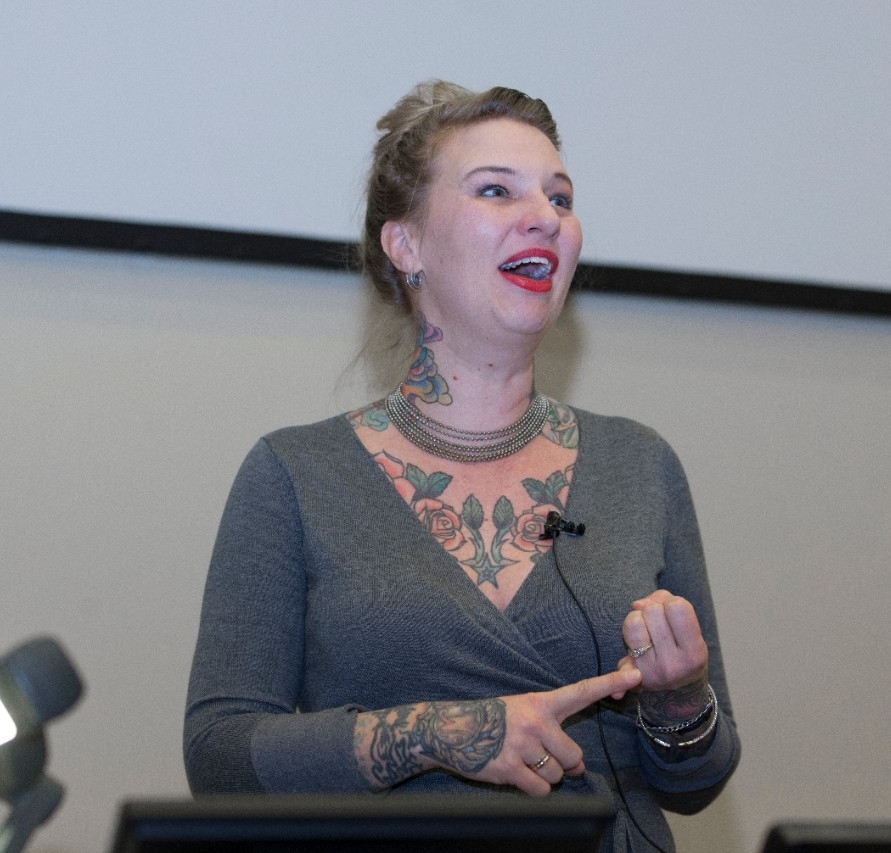
Molly Wellmann
Wellmann is a student of American whiskey in all of its splendid variations but leans strongly to Kentucky bourbon. Her Old Kentucky Bourbon Bar in Covington stocks 600 kinds. Wellmann knows something about each whiskey label.
During Prohibition, doctors would prescribe pints of whiskey to patients for afflictions both real and imagined, she said.
“They would go in and say, ‘Doctor, oh, my gosh, my eyebrows hurt,’” she said.
Wellmann said Cincinnati has a storied history of speakeasies and bootleggers, including the notorious George Remus, a pharmacist, lawyer and accused murderer who was acquitted of shooting his wife in Eden Park in 1927.
“He defended himself and pleaded not guilty by reason of temporary insanity,” she said.
Wellmann said she is always trying to learn something new about the spirits she dishes up at Japp’s, Myrtle’s Punch House and the Old Kentucky Bourbon Bar.
“Alcohol has to be respected. If you respect alcohol, it will respect you,” she said.
Wellmann’s spring cocktail:
The Southside
“It’s a classic cocktail from the 1920s that is really easy that almost anybody can make,” Wellmann said. In a shaker add:
1.5 ounces of good gin.
A half-ounce of fresh-squeezed lemon juice.
A half-ounce of Triple sec.
A sprig of fresh mint.
“Shake it up, strain it into a cocktail glass and enjoy!”
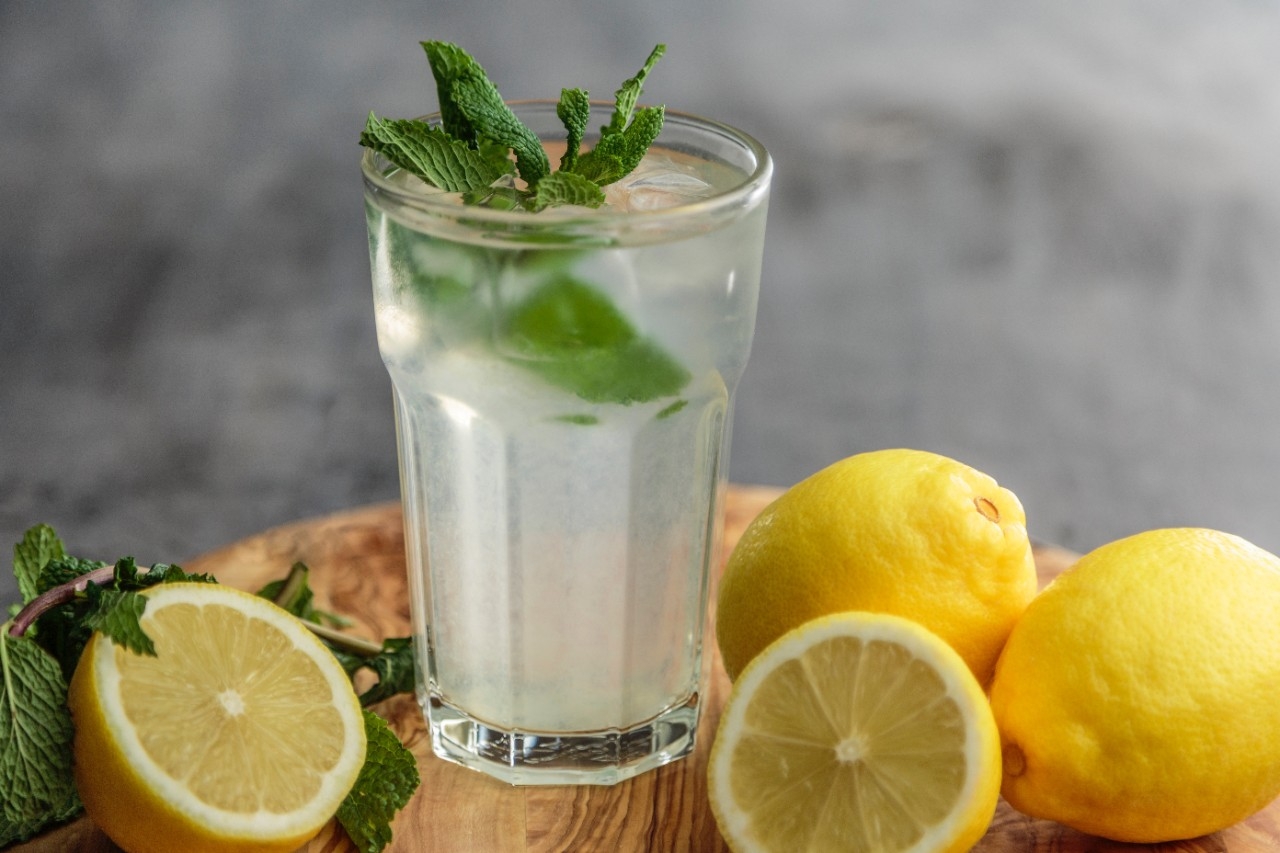
Cincinnati mixologist Molly Wellmann recommends a cocktail called the Southside made with gin, lemon, Triple Sec and fresh mint. (Photo by Francesca Hotchin/Unsplash)

UC students listen to guest speaker Molly Wellmann during a presentation in their medical botany class.
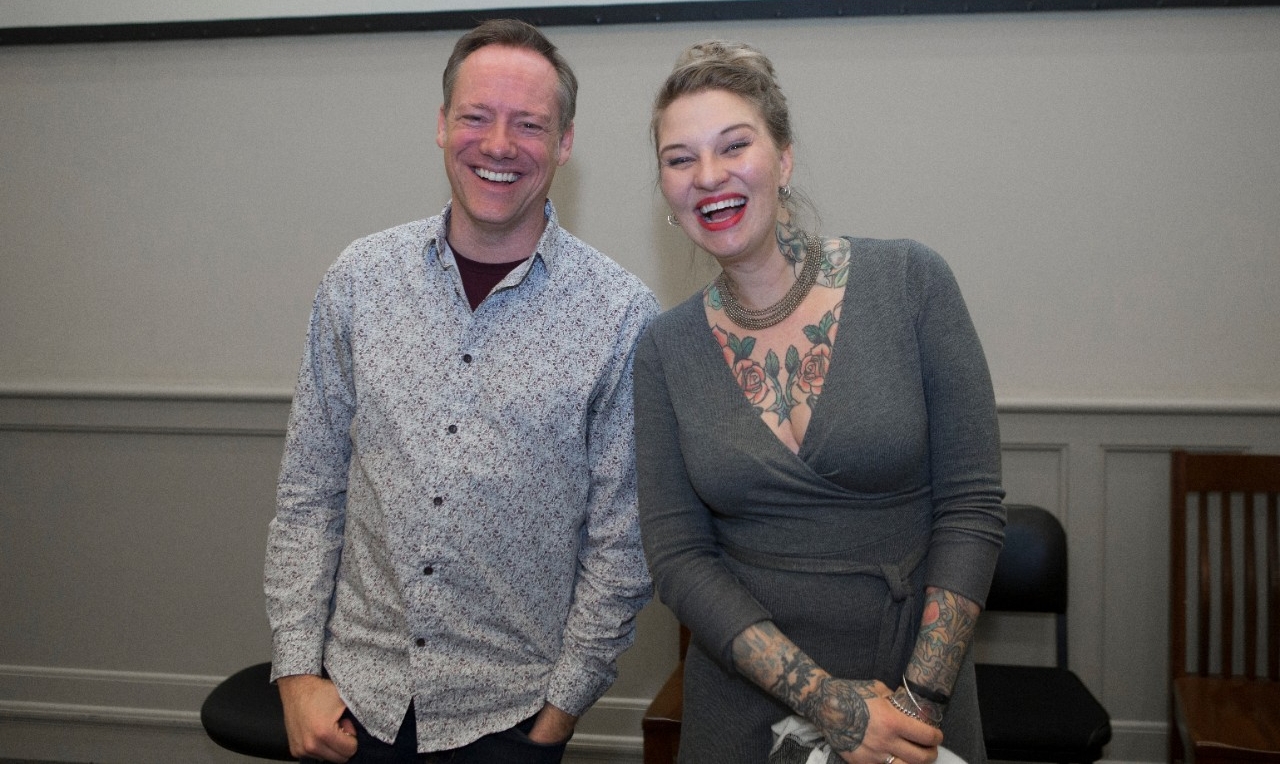
UC biology professor Eric Tepe, left, and guest speaker Molly Wellmann pose for a photo after her presentation to a medical botany class.
Experts in every subject
UC attracts a variety of guest speakers who share their experience and knowledge. Check out the Department of Biological Sciences or explore other programs on the undergraduate or graduate level.

